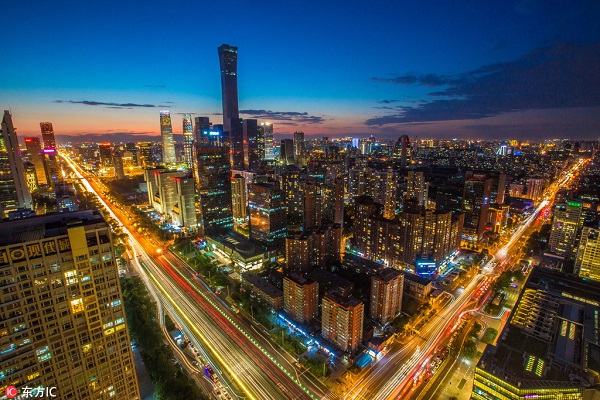Jingjinji Economic Circle
govt.chinadaily.com.cn Updated: Oct 18, 2018

Brief introduction:
Jingjinji refers to the Beijing-Tianjin-Hebei urban economic circle, which mainly covers Beijing, Tianjin and Hebei’s Shijiazhuang, Tangshan, Cangzhou, Baoding, Qinhuangdao, Langfang, Chengde, Zhangjiakou, Xingtai and Handan.
It is positioned as a world-class city cluster taking Beijing as its core and aims to lead the coordinated development and reform of the region, and serve as a new engine of innovation-driven economy and a demonstration zone for ecological conservation in China.
It features a layout of “one core, two cities, three axes, four areas and multiple nodes”, which is expected to help phase out Beijing’s non-capital functions.
One core refers the city of Beijing. Removing the non-capital functions of Beijing, optimizing the core functions of the capital city and addressing the urban problems is the priority of the Beijing-Tianjin-Hebei Coordinated Development Plan.
Two cities refer to Beijing and Tianjin, the main engine for the Beijing-Tianjin-Hebei Coordinated Development. Efforts shall be made to strengthen the coordination between Beijing and Tianjin, expand the breadth and depth of cooperation in an all-round way, speed up the integrated development of the two cities, and jointly play a leading role in the plan.
Three axes refer to three industrial development belts and urban agglomeration axes -- Beijing-Tianjin, Beijing-Baoding-Shijiazhuang, and Beijing-Tangshan-Qinhuangdao. They serve as the main structure supporting the Beijing-Tianjin-Hebei Coordinated Development.
Four areas -- the core functional zone in the center, the coast development zone in the east, the function exploration zone in the south and the ecological conservation zone in the south; each of them has been clearly designated a location and has their own development goals.
Multiple nodes -- Shijiazhuang, Tangshan, Baoding, Handan, Zhangjiakou, Chengde, Langfang, Qinhuangdao, Cangzhou, Xingtai, and Hengshui. They focus on improving the services and promoting the agglomeration of population and industries.
National strategy:
The State Council released the Official Reply of the State Council on the Program for Systematically Promoting Comprehensive Innovation and Reform Trials in Beijing, Tianjin and Hebei on June 24, 2016.
According to the document, Beijing will play a leading role in national technological innovation.
Based on regional trials of innovation demonstration zones and high-tech development zones, further efforts will be made to integrate innovation, industries, capital and policies among Beijing, Tianjin and Hebei.
It will establish a regional innovation system, promote a coordinated Beijing-Tianjin-Hebei innovation community, and build a new zone that supports China’s economic development.
Governments in Beijing, Tianjin and Hebei will put together their joint efforts and improve coordinating mechanisms to carry out the plan.
The National Development and Reform Commission and Ministry of Science and Technology are urged to guide the reform trials.
Investment advantages:
1. Superior geographic advantages.
The Jingjinji region was once called Youyan and Yanzhao in ancient times. During the Yuan (1271-1368), Ming (1368-1644) and Qing (1644-1911) dynasties, Beijing, Tianjin and Hebei were under the same jurisdiction. They belonged to Zhongshu sheng (the Central Secretariat) in Yuan Dynasty, Beizhili (Northern Zhili Province) in Ming Dynasty and Zhili Province in Qing Dynasty.
In early Republic of China (1912-1949), Beijing was called Jingzhao and Tianjin belonged to Zhili Province. After Nanjing was chosen as the capital city of the Republic of China, Beijing was renamed Beiping and belonged to Hebei Province together with Tianjin.
The geographical position, similarities in culture and history make their integrated development possible. Jingjinji is located in the heartland of China’s Bohai Rim in Northeast Asia, boasting the largest and most dynamic economy in northern China and drawing increasing attention of China and even the world.
2. Abundant natural resources
Jingjinji is rich in oil and gas and has abundant sea salt, a large number of metal, non-metallic mineral resources as well as land resource with great potential.
Scientific and technological innovation
Jingjinji has been working on innovations. Beijing, Tianjin and Hebei are devoting to promoting cooperation on science and technology, making joint efforts in achieving breakthroughs, solving major common scientific issues, promoting the application, sharing and commercialization of the achievements.
Integrated transportation
The currently under construction “Jingjinji on rail” project helps expand the Beijing-centered “half-an-hour commuting circle” and promote the connections among cities in the region. With the construction of high-speed railways in Hebei, “making a journey anytime you wish” becomes possible for Hebei residents in the region or even in the whole country.
Rapid economic development
The GDP of Beijing-Tianjin-Hebei region in 2016 was 7.5 trillion yuan ($1.08 trillion), 700 billion higher than that of the Pearl River Delta and ranking second among China’s five city clusters including Yangtze River Delta and Chengdu-Chongqing city clusters. The per capita GDP was 67,524 yuan, higher than the national average of 53,980 yuan, ranking third in the five city clusters.
Favorable policies
With the implementation of a group of pragmatic policies and measures, the coordinated development of Beijing, Tianjin and Hebei is on the right track and a large and powerful world-class city cluster is emerging. The provincial government of Hebei has released a document consisting 27 measures that encourage overseas investment in key fields, reduce the cost of foreign-funded enterprises, create a fair and competitive market environment, build a platform for international cooperation and ensure the implementation of policies relating to foreign investment.
![]()





